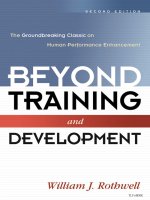Employee training and development 5th chapter 09
Bạn đang xem bản rút gọn của tài liệu. Xem và tải ngay bản đầy đủ của tài liệu tại đây (875.12 KB, 36 trang )
Chapter 9
Employee Development
McGraw-Hill/Irwin
Copyright © 2010 by the McGraw-Hill Companies, Inc. All rights reserved.
Introduction
Development - formal education, job
experiences, relationships, and
assessments of personality and abilities
that help employees perform effectively
in their current or future job and
company.
9-2
Table 9.1 - Comparison Between
Training and Development
9-3
Introduction (cont.)
Why is employee development
important?
To improve quality.
To meet the challenges of global competition
and social change.
To incorporate technological advances and
changes in work design.
9-4
Introduction (cont.)
Development activities can help
companies reduce turnover by:
showing employees that the company is
investing in the employees’ skill development.
developing managers who can create a
positive work environment that makes
employees want to come to work and
contribute to the company goals.
9-5
Approaches to Employee
Development
Formal education programs include:
off-site and on-site programs designed
specifically for the company’s employees.
short courses offered by consultants or
universities, executive MBA programs, and
university programs.
Tuition reimbursement - the practice of
reimbursing employees’ costs for college
and university courses and degree
programs.
9-6
Approaches to Employee
Development (cont.)
Assessment
Collecting information and providing feedback
to employees about their behavior,
communication style, values, or skills.
Used most frequently to identify employees
with managerial potential, and measure
current managers’ strengths and weaknesses.
Companies vary in the methods and sources
of information they use in developmental
assessment.
9-7
Approaches to Employee
Development (cont.)
Myers-Briggs Type Indicator (MBTI)
Most popular psychological test for employee
development.
Identifies individuals’ preferences for energy,
information gathering, decision making, and
lifestyle.
It is a valuable tool for understanding
communication styles and the ways people
prefer to interact with others.
9-8
Table 9.4 - Personality Types Used in the
Myers-Briggs Type Indicator Assessment
9-9
Table 9.4 - Personality Types Used in the
Myers-Briggs Type Indicator Assessment
9-10
Approaches to Employee
Development (cont.)
Assessment center - multiple raters or
evaluators evaluate employees’
performance on a number of exercises.
It is used to identify:
if employees have the abilities, personality, and
behaviors for management jobs.
if employees have the necessary skills to work in
teams.
Types of exercises used include leaderless
group discussions, interviews, in-baskets, and
role plays.
9-11
Table 9.5 - Examples of Skills Measured
by Assessment Center Exercises
9-12
Approaches to Employee
Development (cont.)
Benchmarks - instrument designed to
measure important factors in being a
successful manager.
Items that are measured include dealing with
subordinates, acquiring resources, and
creating a productive work climate.
9-13
Table 9.6 - Skills Related to
Managerial Success
9-14
Approaches to Employee
Development (cont.)
Performance appraisal - process of
measuring employees’ performance.
Different approaches for measuring
performance:
Ranking employees.
Rating their work behaviors.
Rating the extent to which employees have
desirable traits believed to be necessary for job
success.
9-15
Approaches to Employee
Development (cont.)
The appraisal system must give employees
specific information about their performance
problems and ways they can improve their
performance.
Managers must be trained in providing
performance feedback.
Upward feedback - involves collecting
subordinates’ evaluations of managers’
behaviors or skills.
9-16
Figure 9.1 - 360-Degree Feedback
System
9-17
Table 9.8 - Development- Planning
Activities from 360-Degree Feedback
9-18
Approaches to Employee
Development (cont.)
Factors necessary for a 360-degree
feedback system to be effective:
The system must provide consistent or
reliable ratings.
Feedback must be job-related (valid).
The system must be easy to use,
understandable, and relevant.
The system must lead to managerial
development.
9-19
Approaches to Employee
Development (cont.)
Job Experiences - relationships,
problems, demands, tasks, or other
features that employees face in their
jobs.
A major assumption is that development is
most likely to occur when there is a mismatch
between the employee’s skills and past
experiences and the skills required for the job.
9-20
Table 9.9 - Job Demands and the
Lessons Employees Learn from Them
9-21
Table 9.9 - Job Demands and the
Lessons Employees Learn From Them
9-22
Figure 9.2 - How Job Experiences are
Used for Employee Development
9-23
Approaches to Employee
Development (cont.)
Job enlargement - adding challenges or
new responsibilities to an employee’s
current job.
Job rotation - providing employees with
a series of job assignments in various
functional areas of the company or
movement among jobs in a single
functional area or department.
9-24
Table 9.10 - Characteristics of
Effective Job Rotation Systems
9-25









